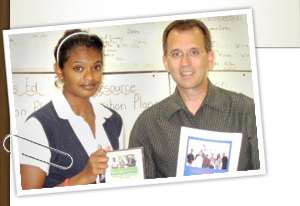Circle of Friends
Circle of Friends is a network building tool. Various adaptations of this tool exist. When used in a school it is based upon the idea of inviting potential friends to join a group centred around an individual with an intellectual disability. It is meant to enhance the inclusion of individuals by mobilizing their schoolmate peers to help them. This increased exposure to each other creates positive results for all involved.
A School’s Practices of Inclusion
Marigold Thompson was in school with Jonathan. She talks about the ways in which integration and good planning helped her and other students get to know Jonathan and the other students with disabilities. Today she herself is a young teacher. She continues to be one of Jonathan’s friends.
Download TranscriptA Circle for a student will consist only of people in the school – three or four mainstream students, perhaps an educational assistant, one or two teachers, and ideally, a family member or a volunteer from outside the school who can help sustain the Circle beyond school hours. Teachers help set it up, provide a place to meet, and provide input at the start, but they should fade out as possible. The young person with a disability may be able to give leadership, but in any case, their desires and interests should be central. Peers should be encouraged as much as possible to take their commitment outside of school hours, and families of the students should be linked in and helped to get to know each other so they can facilitate this.
If it is set up properly and the right people are invited, the Circle may become almost self-sustaining. If the relationships develop well, they may be sustained long after graduation. A strong support network is very important in smoothing the transition from school into adult life. Some of these school friends may well become part of a circle that will continue through adulthood. )

Role of Educators in Helping a Circle to Form
Educators and other support people need to be trained to look for the common bonds and reinforce them. When the bonds emerge in school these may be largely wasted unless there is support from school personnel and a plan for some follow-through.
Parent, BC
This document explains “Circle of Friends” and how to use this tool. (It can also be helpful to young people in deciding how close a friends is. This can help with knowing how to act with that friend.)
(Extracted with permission from the 2009 Inclusion Press booklet, “Planning for Real Life after School”, prepared by the Marsha Forest Centre.)


